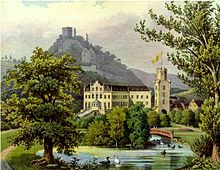Sayn Castle
Sayn Castle is a castle at the foot of the castle hill of Sayn Castle , at the entrance to Sayn , a district of Bendorf in the Mayen-Koblenz district.
history
The origins of the castle lie in a medieval Burgmannshof from the 14th century, which was built for the Lords of Reiffenberg , ministers of the Counts of Sayn . Above the castle stands on a mountain spur the Sayn Castle , the ancestral home of the Earls of Sayn. Their inheritance fell in 1247 to a line of the Counts of Sponheim , which then formed the younger line of the Counts of Sayn and in 1361 also inherited the County of Wittgenstein , whereupon the family zu Sayn-Wittgenstein called themselves . The possessions were continued in two lines from 1361, the area around Sayn , Altenkirchen and Hachenburg in the Sayn-Sayn line and the territories around Homburg and the Wittgensteiner Land around Laasphe and Berleburg in the Sayn-Wittgenstein line .
Count Ludwig I reunited the two counties in one hand, but in 1605 divided his inheritance between his three sons: the eldest received Berleburg, the second Wittgenstein and the third, Count Wilhelm III., The County of Sayn, since he and Countess Anna Elisabeth von Sayn, the last descendant of the Sayn-Sayn line, which died out in the male line in 1606. He founded the (older) line of the Counts of Sayn-Wittgenstein-Sayn. However, this line died out as early as 1636, the inheritance was divided into the County of Sayn-Hachenburg and the County of Sayn-Altenkirchen , both of which then fell to other houses through female inheritance.
Prince Ludwig Adolph Friedrich zu Sayn-Wittgenstein-Ludwigsburg (1799–1866), eldest son of the Imperial Russian Field Marshal Prince Ludwig Adolph Peter from a younger branch of the Berleburger line, returned from Russia in 1848 with his wife Leonilla Barjatinsky (1816–1918), received by the Prussian king Friedrich Wilhelm IV. the castle Sayn paid and acquired in 1848 and the location at the foot of the castle hill, medieval core refurbished in baroque style mansion that recently the family Boos of Waldeck had heard. In the same year, the prince and his Russian wife Leonilla commissioned the French architect François Joseph Girard , who later became General Manager of the Louvre in Paris , to convert the manor house into a palace in the neo-Gothic style and to expand it in line with contemporary tastes. From 1860 to 1862 , Hermann Nebel built a double chapel based on the model of the Sainte-Chapelle at its eastern end . The precious arm reliquary of Elisabeth of Thuringia is kept there.
The castle was badly damaged in World War II shortly before the end of the war. It fell into ruin, only the outer walls remained, the chapel remained largely undamaged. It was not until the 1990s that the reconstruction was planned and the old structure was restored. The work was completed in 2000. The current owner is Prince Alexander zu Sayn-Wittgenstein-Sayn .
use
Sayn Castle housed, among other things, the Rheinische Eisenkunstguss-Museum until autumn 2019 , which could be visited together with the princely salons from the beginning of March to the beginning of December. There is also a restaurant there. After the Eisenkunstguss Museum moved out, Princess Gabriela and Prince Alexander zu Sayn-Wittgenstein-Sayn set up an exhibition on the history of the family in the vacant rooms on an area of around 1000 square meters. The main themes are the princesses Leonilla (1816–1918) and Marianne . In addition to numerous paintings, including those from the former royal court in Russia, you can see elaborately designed dresses from the 19th and early 20th centuries. The princely family's interest in motorsport is reflected in many of the photos, some of them large-format, taken by Marianne zu Sayn-Wittgenstein-Sayn (* 1919).
In the Princely Palace Park, an English landscape garden from the 19th century, you will find the Sayn Palace Butterflies Garden , which can also be visited.
literature
- Heiderose Engelhardt: Schloss and Burg Sayn Deutscher Kunstverlag , Munich 2006, ISBN 3-422-02031-4 (= DKV art guide, issue No. 637)
- The Middle Rhine Basin (= values of the German homeland . Volume 65). 1st edition. Böhlau, Cologne / Weimar / Vienna 2003, ISBN 978-3-412-10102-2 .
- Udo Liessem: Comments on the architectural, art and intellectual history of the palace in Sayn . In: Alexander Prince of Sayn-Wittgenstein-Sayn (ed.): Sayn - place and royal house . o. O., o. J. (Bendorf-Sayn 1979), pp. 149-168.
Web links
- Sayn Castle
- Sayn Castle in the Alexander Duncker Collection (PDF file; 295 kB)
Individual evidence
- ^ Sayner Museum is moving . In: Rhein-Zeitung No. 258, Issue B0, from November 7, 2019, p. 21.
- ↑ Annika Günther: Princely insights into life at court . In: Rhein-Zeitung No. 51 of February 29, 2020, issue B0, p. 21.
Coordinates: 50 ° 26 ′ 18.4 " N , 7 ° 34 ′ 38" E




